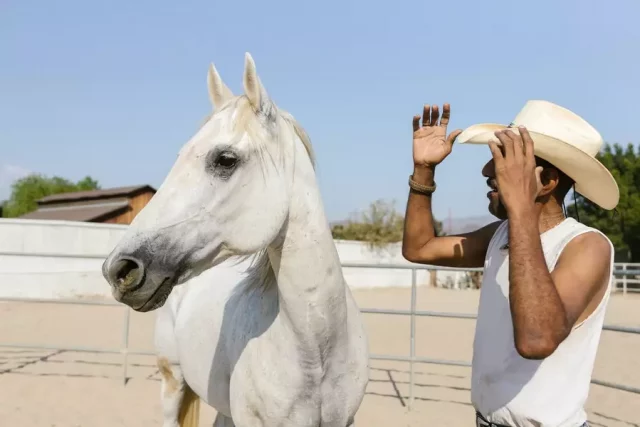If you’re a horse owner, it’s essential to learn how to keep your horse healthy and fit. Horses are athletes, and they need to be exercised and well-fed to stay healthy. This article will discuss the basics of horse care, including feeding, exercise, and grooming. We’ll also cover some common health problems that horses can experience, and we’ll provide tips on how to prevent them. So read on for helpful advice on how to keep your horse in top shape!
Feed Your Horse A Healthy Diet
The general rule is “a little bit, often.” In other words, feed small amounts of food regularly. This will help prevent digestive problems and keep your horse’s energy level stable. The type of feed you use depends on the season and your horse’s condition.
For example, horses need hay or other dried forage during the winter as their primary food source. During the summer, when pasture is available, you can feed your horse small amounts of food several times a day; horses in light work may need less. Ask your veterinarian what and how much to feed your horse.
Additionally, horses require nutritional support in their feed for overall health. It will be best to add Milk thistle for horses on your equine diet to provide a boost of vitamins, antioxidants, and enzymes. It also helps maintain a healthy liver by supporting the regeneration of new liver cell growth. Minerals such as selenium, copper, and zinc help with joint and hoof health. Vitamin supplements such as vitamin E help prevent reproductive problems in horses, and vitamin C reduces the risk of gastric ulcers in some horses.
Exercise Your Horse Properly
Like humans, horses need exercise to stay healthy. Even if your horse spends his days in a pasture or paddock, he should have routine activities to keep him fit and coordinated. This is good for all horses, especially those being trained for riding or work.
The best way to keep your horse active is to take him on regular rides, whether around the barnyard or in more challenging terrain. This is another excellent option if you have a safe area to let him run free. But be sure to provide some restraint, so he doesn’t get away from you.
It’s also crucial that you always have a way to exercise your horse even if the weather is terrible or you have an injury. Ask your vet for some suggestions on what types of activities would be appropriate and safe for your horse.
Avoid the temptation to feed your horse treats while you’re riding him. Food rewards can unbalance his diet, and they may even cause him to act out of character during exercise. Instead, provide food as a reward after exercising for good behavior.
Pay Attention To Your Horse’s Living Space
You need to pay attention to the condition of your horse’s living space as well. Horses need access to clean, dry bedding and shelter from the elements. They should always have a consistent place to eat and drink – never shifting locations; these things can cause accidents or health problems for your horse.
Think about what type of protection each season offers for shelter. In the winter, horses need a small shed or barn with enough room to move around and get away from drafts. During the fall and spring, when there is no snow on the ground, your horse might not need shelter at all unless he enjoys spending time in it.
In cases where you can’t provide shelter from rain or sun, consider buying a tarp to place over your horse’s feed. If there is a time of year when it often rains, make sure the surface where your horse walks isn’t too slick. You may need to spread sawdust or shavings over the ground for traction during wet weather.
Keep Your Horse’s Hooves Healthy
Keeping your horse’s feet in good shape is another easy way to ensure he remains safe and comfortable. Whether you ride your horse or not, his hooves still need attention to keep him free from pain and infection. The best action plan is to have experienced farrier care for your horse’s feet at least two times a year.
Horses that go for regular farrier care usually need to be trimmed about every six weeks, but this could vary depending on how your horse walks and stands and the shape of his hooves. If you aren’t sure whether your horse needs to be seen by a farrier or not, contact one in your area to schedule a consultation.
Control Pests In Your Barn
Finally, it’s crucial to deal with pests in your barn. Biting insects are harmful to any horses who spend time outside. And some of these same bugs can spread diseases that affect both horses and humans, particularly Lyme disease.
To control an insect problem inside the barn, you need to reduce the number of places insects can hide. This includes cleaning your horse’s bedding and removing debris from the barn floor. Then, you should use a product that will keep insects away without harming horses or humans. There is a wide selection of sprays and powders available at feed stores and online retailers.
Grooming Your Horse
Your grooming routine will change depending on whether you ride your horse or not. However, no matter how often or little you exercise your horse, it’s vital that his coat is clean and free from tangles. A dirty coat can lead to infections and discomfort for your horse, while mats, dirt, and other debris can clog glands and lead to irritation.
Regular grooming is essential for horses that live in the wild or spend time on dusty trails. If they don’t get regular baths, they may need a veterinarian’s help to control skin conditions like rain rot and scratches.
To keep your horse clean, use a stiff brush to rid him of dirt, dander, and pollen that might be caught in his coat. His mane and tail will need extra attention if they are long or you want them braided for special occasions. If necessary, ask someone who knows how to braid manes and tails to teach you how to do it safely.
When it comes to taking care of your horse’s health, these steps are a great place to get started. If you have any questions about how to maintain your horse’s general wellbeing, consider asking an equine veterinarian for advice.














